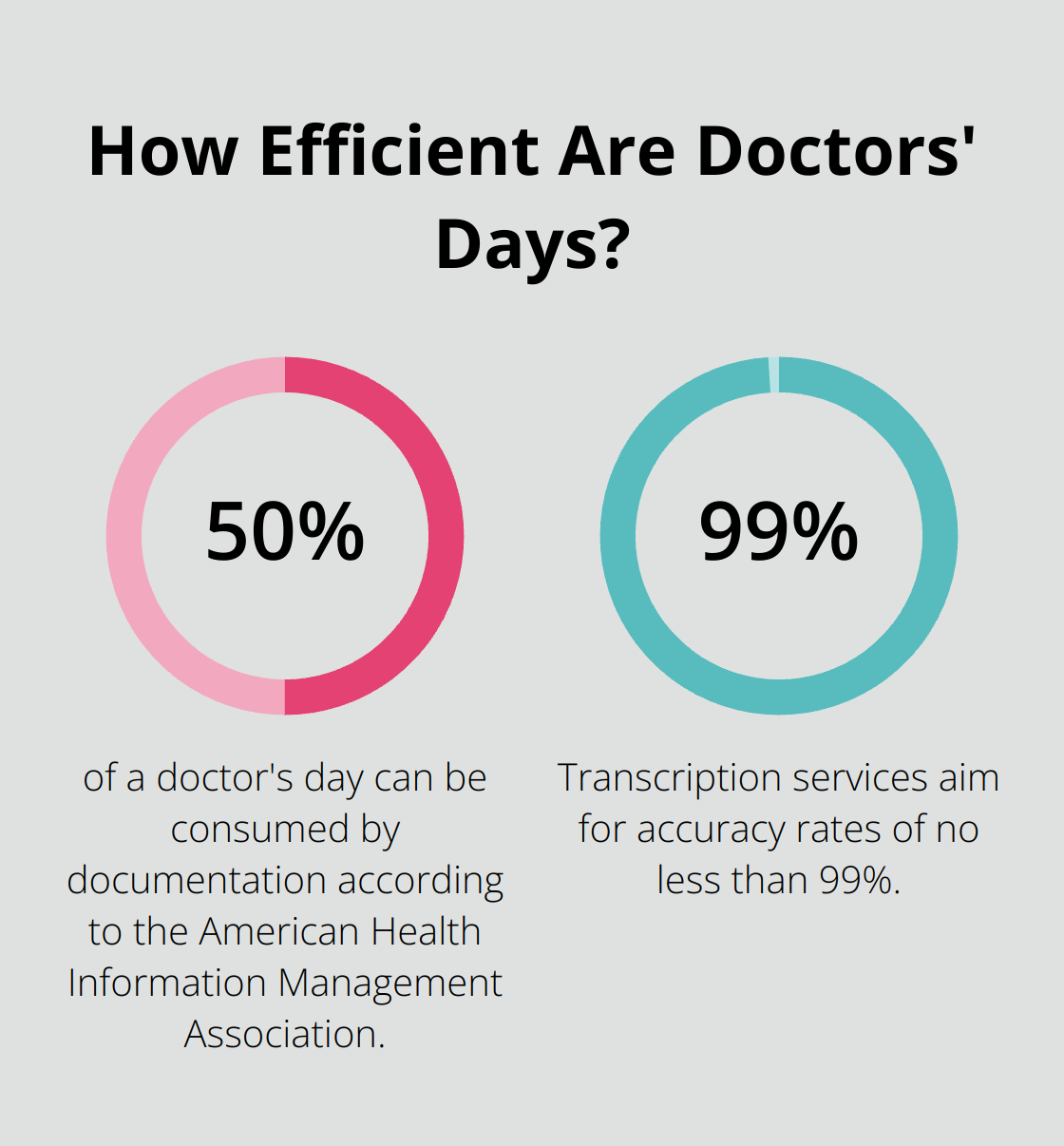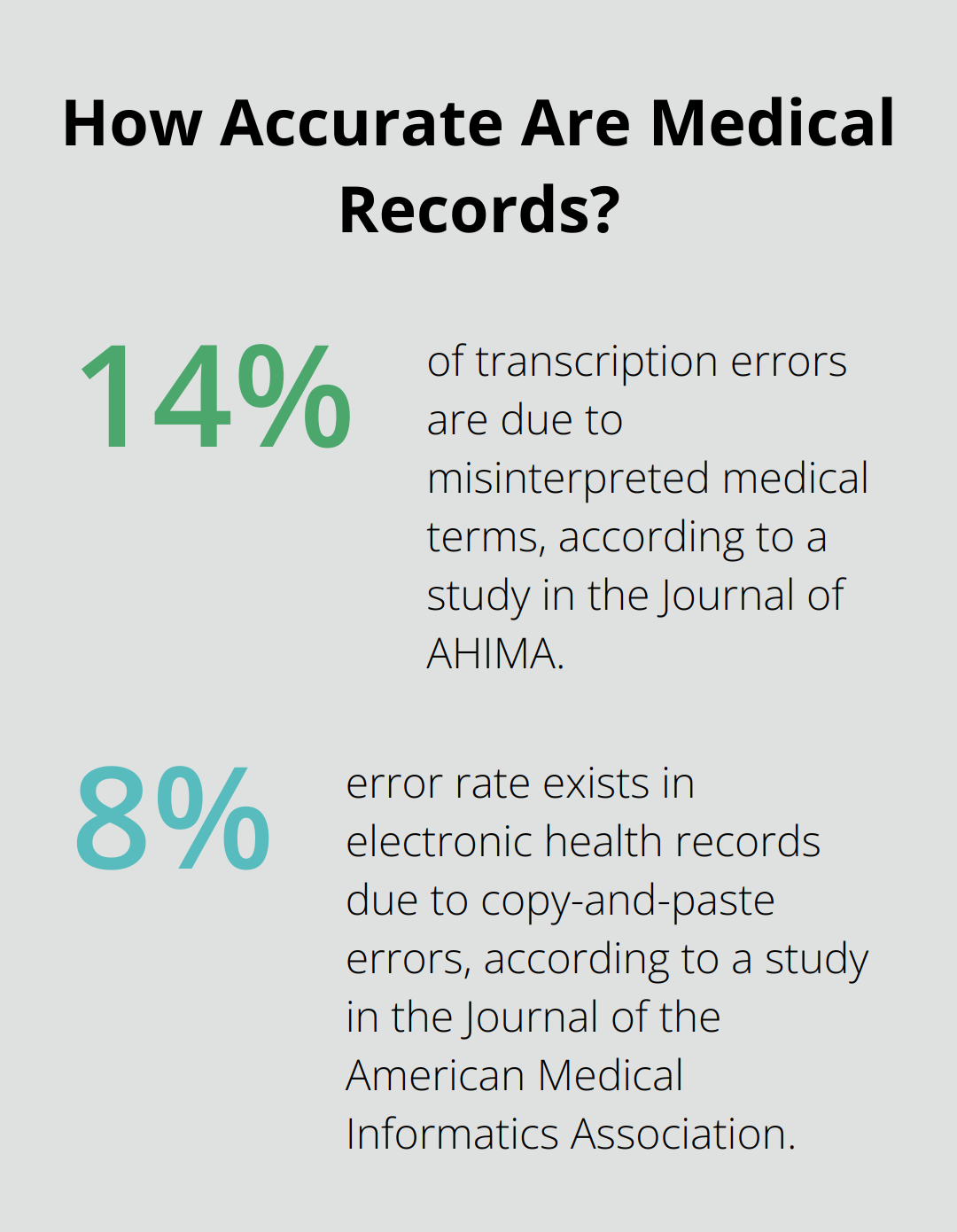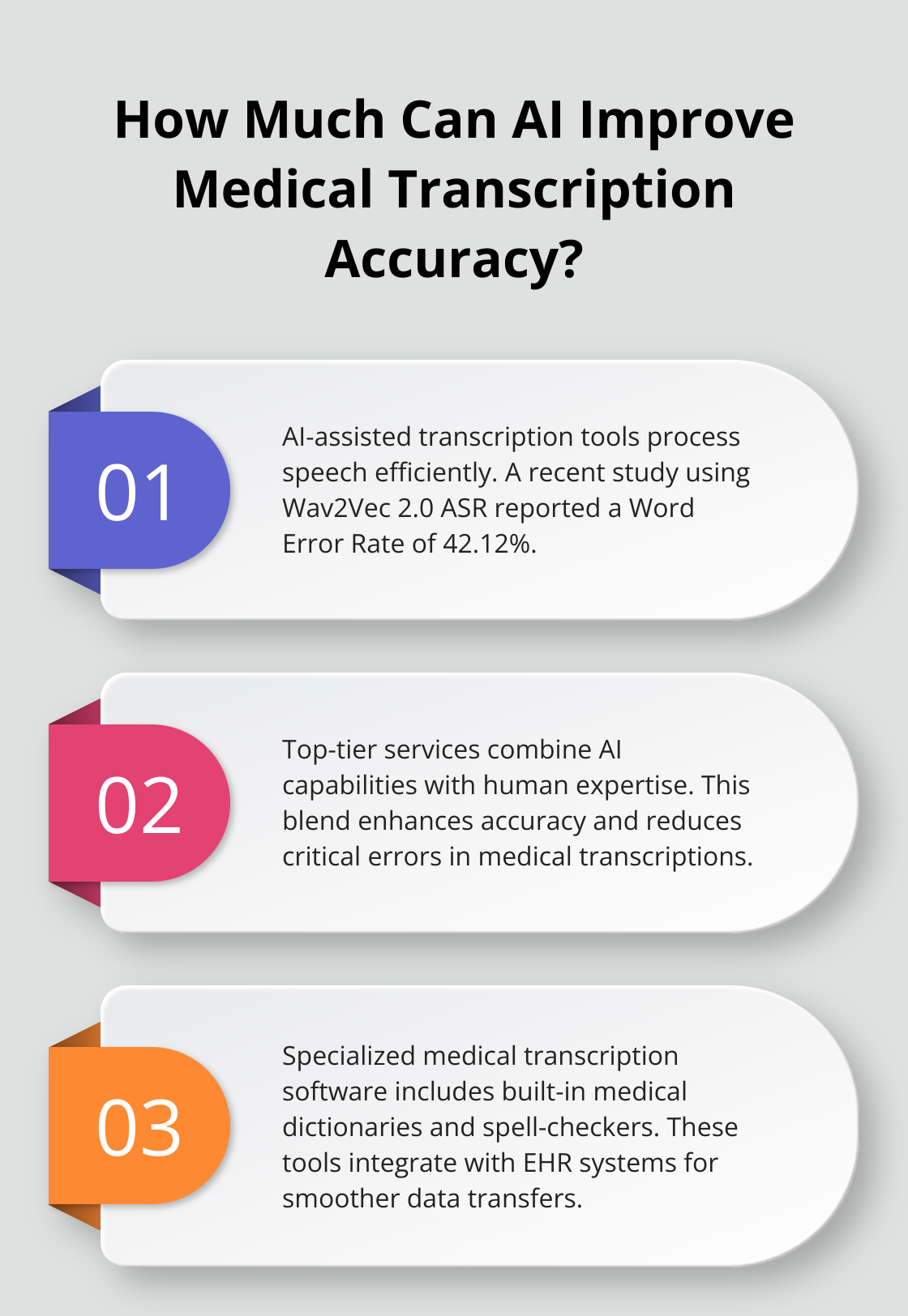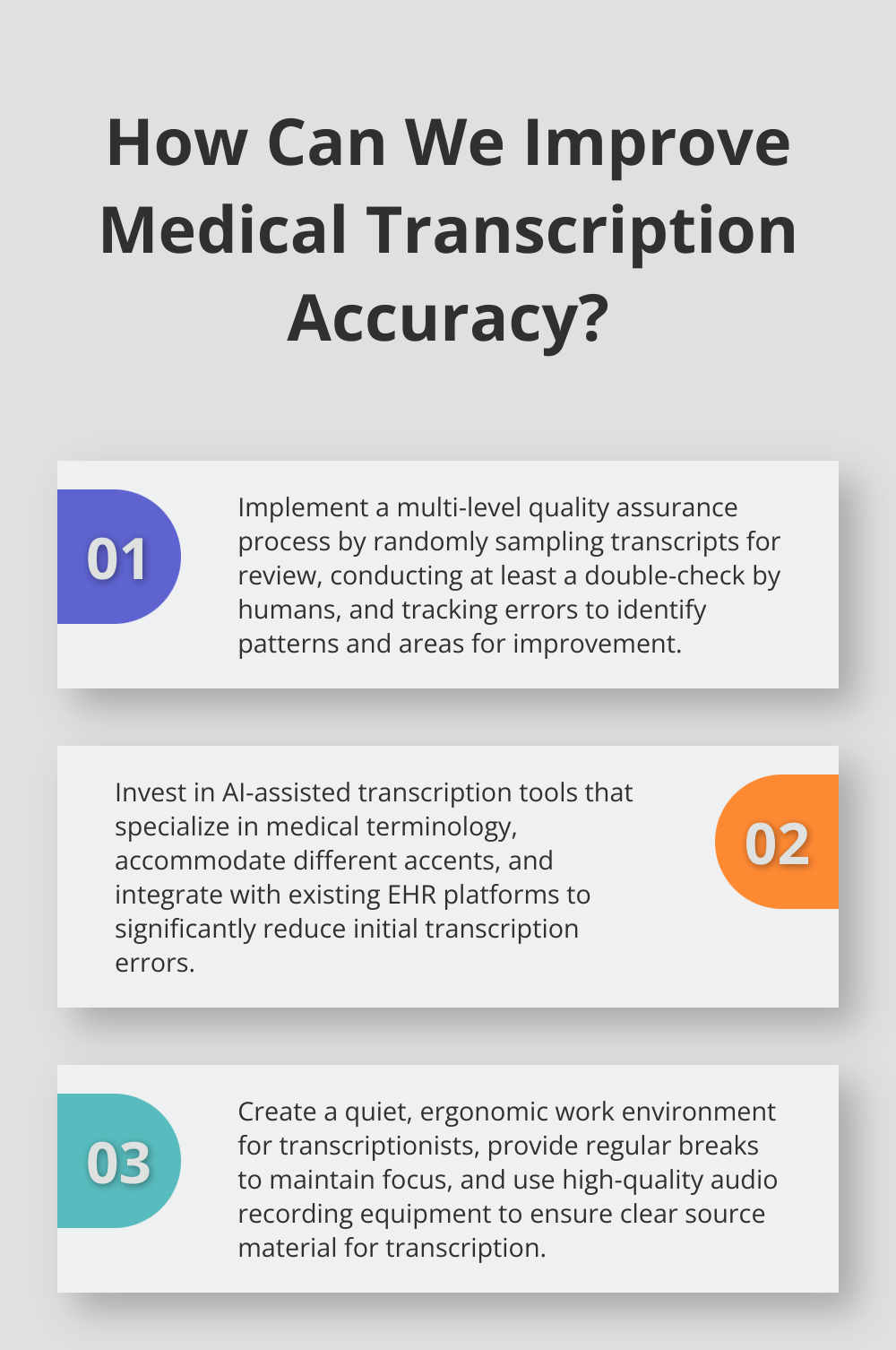Getting medical transcription right… it’s not just important—it’s crucial. Imagine a world where documentation is spot-on, lives can literally hang in the balance. That’s where we, ScriberJoy, come in. We totally get how this needs to be a top priority for patient care, legal hoops, and the nitty-gritty of healthcare nuts and bolts.
Screw up in the records department? Say hello to big-time problems. You’ve got everything from botching up meds to getting diagnoses wrong. So, let’s dig into why nailing accuracy in medical transcription isn’t just a nice-to-have. Spoiler: It’s essential. And the cherry on top? We’re spilling the beans on how to hit that bullseye.
Why Accuracy in Medical Transcription is Non-Negotiable
The Critical Nature of Precision in Healthcare Documentation
So, medical transcription accuracy-it’s basically the bedrock of healthcare effectiveness. There’s this study showing a 2.02% error rate in single-key data entry for patient questionnaires. You may think, “2% sounds tiny,” but in massive healthcare systems, that’s thousands of potential blunders. Precision isn’t just a buzzword-it’s a necessity.
Patient Safety: The Ultimate Priority
We’re talking life and death here, folks. Even a teeny mistake can snowball into disaster-a decimal in the wrong place or a muffled drug name, and suddenly, we have severe complications. Mix up “hypertension” with “hypotension”? Boom, you’ve got treatments going in the complete opposite direction. That’s why transcription services aim for accuracy rates that skirt nothing less than 99%.
Legal Implications of Accurate Records
Precise documentation is your armor in malpractice suits. The National Practitioner Data Bank is all about noting down demands for payment. Many cases hinge-like Tarzan-from the quality of your records. When transcription is on point, healthcare pros have a solid defense, keeping their decision-making and actions crystal clear and legally shielded.
Enhancing Operational Efficiency
Mistakes here, mistakes there-they’re not just risky; they’re time vampires. Time’s precious, friends, and no one wants to spend it deciphering sloppy notes. The American Health Information Management Association says documentation can hog up to 50% of a doc’s day. By bringing accuracy to the table, healthcare facilities can focus on what really matters: patient care, seeing more patients, and boosting efficiency across the board.
The Evolution of Transcription Accuracy
With each heartbeat of healthcare’s evolution, the demand for spot-on documentation only ramps up. We’re seeing modern transcription services using AI to boost accuracy. But hold on-humans still rock the show for context and nuance in med lingo. This tech-human combo (shoutout to folks like ScribeJoy) is paving the way for medical transcription.

Accurate medical transcription isn’t just about dotting i’s and crossing t’s. It’s the guardian of lives, the protector of healthcare providers, and the turbocharger of healthcare delivery. As we chart the road ahead, let’s dig into common transcription errors and their consequences-a spotlight on where our focus needs to laser aim.
Common Medical Transcription Errors and Their Consequences
Medical transcription errors… they’re like ticking time bombs for patient care, legal compliance, and healthcare operations. Let’s dissect the usual suspects (the errors, that is) and their ripple effects.
Medication Mixups and Dosage Disasters
Medication errors – they’re the granddaddy of all transcription blunders. Studies suggest these mishaps and adverse drug events are bedfellows with 140,000 deaths every year and pop up in one out of 16 hospitalized folks. We’re talking about everything from misheard drug names to those pesky misplaced decimal points in dosages.

Imagine mixing up “morphine” with “hydromorphone” (a recipe for a 30-fold dosage error) or jotting down “5.0 mg” as “50 mg” (a potential overdose disaster waiting to happen). Yep, real-life healthcare horror stories.
Lost in Translation: Medical Terminology Troubles
Oh, the tangled web of medical terminology – a breeding ground for misunderstandings. A study in the Journal of AHIMA spills the beans that 14% of transcription errors are thanks to messed-up medical terms.
Remember that infamous “TPA” mix-up? Someone scribbled it as “TBA” (a gibberish term), which could’ve derailed stroke treatment. Yikes.
Patient History Hiccups
Patient history… it’s the Rosetta Stone for diagnosis and treatment. Flubbing symptoms, allergies, or past conditions can lead to misdiagnosis or improper treatment.
The Joint Commission flagged that half of transition-of-care errors circle back to medication history goofs, many rooted in transcription slip-ups. The fallout? Readmissions, extended hospital stays, or worse – life on the line.
Technological Glitches and Human Error
Sure, tech is supposed to keep bloopers at bay, but it can also stir the pot. Speech recognition might garble accents or get derailed by background noise, baking errors right into the transcript. Pile on human blunders courtesy of fatigue or distraction, and you’ve got a recipe for trouble.
A study in the Journal of the American Medical Informatics Association puts a spotlight on an 8% error rate in electronic health records due to those “friendly” copy-and-paste misadventures, pointing to the dire need for proofreading and verification.
To dodge these minefields, healthcare providers need battle-ready systems. AI-assisted transcription with human double-checking (a service like ScribeJoy) can hit over 99% accuracy, nipping the risk of these blunders in the bud.
Bottom line: these transcription trip-ups scream for attention to detail in medical paperwork. So, what’s next? Let’s dive into strategies to up the transcription accuracy game and carve out safer, more efficient healthcare ecosystems.
How to Boost Medical Transcription Accuracy
Leverage AI-Assisted Transcription Tools
AI-powered transcription tools … they’re flipping the script on medical documentation. These systems process speech like it’s no big deal, but let’s be real – accuracy? It’s a mixed bag. A recent study with Wav2Vec 2.0 ASR threw out a Word Error Rate of 42.12%. Yikes. But hey, AI’s not the whole enchilada. The real magic? Marrying AI smarts with human touch.

Top-tier services? They get it. AI kicks things off, then humans step in for the polish. This blend can crank up accuracy, axing those messy, critical errors.
When you’re on the AI shopping spree, think about this:
- Grab software that eats medical terms for breakfast
- Make sure it jives with different accents and speech vibes
- Got EHR platforms? Find systems that play nice with ’em
Invest in Continuous Education for Transcriptionists
The medical universe is always on the move, and transcriptionists? They’ve got to keep up. Continuous education is the name of the game for keeping things sharp and accurate.
What’s a solid training program look like?
- It spills the tea on new medical terms and procedures
- Dishes the latest on meds and treatments
- Shows the ropes on new rules and compliance hoops
Loads of healthcare outfits are hitching a ride with online learning platforms. This on-demand gig lets transcriptionists learn at their groove while staying in the loop with industry news.
Implement Rigorous Quality Assurance Processes
Quality assurance (QA) … it’s the knight in shining armor warding off transcription slip-ups. A robust QA process? It can work wonders for transcription precision.
Picture an ace QA gig:
- Random sampling: Snag a chunk of transcripts for a deep-dive review
- Multi-level checks: Set up at least a double-check by humans
- Error tracking: Keep tabs on repeat blunders to suss out patterns and areas needing a glow-up
Some healthcare cats are turning to specialized QA tech. These tools shout out potential errors based on context, racing through reviews and keeping the accuracy banner high.
Optimize Work Environment and Practices
The work pad? Oh, it matters heaps for transcription precision. Aim for a quiet, mellow spot for transcriptionists (whether they’re parked at home or in-office). Get ergonomic equipment – zap fatigue, amp up focus.
Best practices to nail:
- Regular escapes to keep concentration from nosediving
- Crystal-clear audio recordings (time to splurge on top-notch gear)
- Consistent formatting and templates to dodge inconsistencies
According to AHDI, transcriptionists are in the line of fire for repetitive stress syndrome thanks to their nonstop read-and-transcribe hustle. Tackle this, and you’re talking about keeping accuracy in lockstep over the long haul.
Utilize Specialized Medical Transcription Software
Dedicated medical transcription software? It’s a game-changer, folks. Think features like:
- Built-in medical dictionaries and spell-checkers
- Tailored voice recognition for medical terms
- EHR system integration making transfers smooth as butter
ScribeJoy, for instance, serves up a powerhouse mix of AI tech and human insight, promising sky-high accuracy and HIPAA harmony.
Final Thoughts
Transcription accuracy in medical settings is… oh, let’s call it-absolutely crucial. We’re talking patient safety, legal compliance, and operational smoothness. You know, the stuff that keeps the world turning. In an ever-evolving landscape, medical transcription is where cutting-edge tech and human expertise have their coffee date, bringing new benchmarks in precision and speed. AI-assisted tools swoop in as the superheroes for initial accuracy, yet our human friends? They add the jazz-nuanced understanding, contextual magic.

The future of nailing medical documentation is tethered to our ever-evolving transcription tactics. Brace yourself for deeper AI integration, more sophisticated quality checks (AKA the failsafes), and a whole lot of schooling for budding transcriptionists. These upgrades inch us closer to transcribing utopia, raising the bar for healthcare quality across the board.
Enter ScribeJoy-a frontrunner in this race for excellence. By marrying AI-driven transcription with human double-checking, ScribeJoy reshuffles the deck for high accuracy in medical documentation. This dynamic duo not only boosts precision but lets healthcare professionals zero in on patient care-cementing transcription accuracy as the backbone of stellar healthcare delivery.

Leave a Reply
You must be logged in to post a comment.